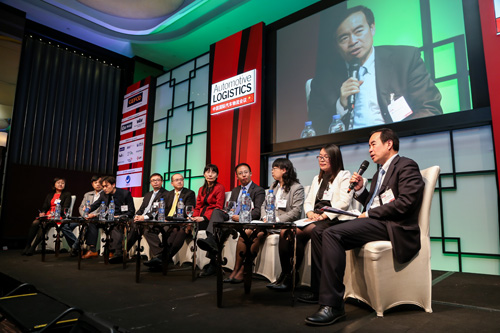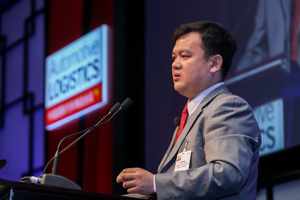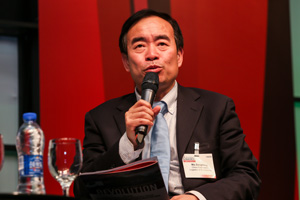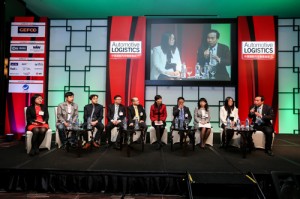 Speakers at the 12th annual Automotive Logistics China conference pointed to efforts at both the government and industry level to improve services, become more efficient, market orientated, and international, particularly with growth slowing down. Christopher Ludwig and Rachael Hogg report from Shanghai
Speakers at the 12th annual Automotive Logistics China conference pointed to efforts at both the government and industry level to improve services, become more efficient, market orientated, and international, particularly with growth slowing down. Christopher Ludwig and Rachael Hogg report from Shanghai
There is no getting around just how big the world’s largest market for vehicle production and sales is. Last year, China’s new light and commercial vehicle market grew by nearly 7% to 23.5m units. Global carmakers, tier suppliers and their local joint ventures continue to open up new production plants in the country, expanding their supply chain and sales networks not only along China’s wealthy east coast in Beijing, Shanghai and Guangzhou, but deeper into central and western China, including Shanghai Volkswagen’s upcoming new plant in Changsha, new Changan Ford and SAIC-GM-Wuling plants in Chongqing and Volvo Cars in Chengdu.
This expansion in production regions, along with fast-growing demand for new vehicles in smaller cities and rural areas, has been fuelling demand for complex, reliable logistics services.

Although the rate is high by western standards, this slower rate is part of wider changes in the Chinese economy that are having ripple effects throughout industry. For industrial sectors, there is a notable slowdown in growth. The purchasing managers index, which measures the rate of investment and purchasing among manufacturers, was 49 for the first quarter (readings below 50 indicate a contraction), compared to 55 in the first quarter of 2014, said Cai. The March reading was back above 50, and the readings for mass products and consumables have been rising, but China is feeling the effects of changing policies, including a reduction in excess capacity in certain industries as well as the government’s anti-corruption drive.
- The new normal
- On the road to openness
- One road, one belt
- Supply chain quality
- Standards and reforms won't help everyone
More stories from Shanghai
- Building better logistics
- Qoros outsources sequencing to BCUBE
- Panel discussion: quality versus quantity
- Life under the New Normal
- Challenges and Opportunities
- China's automotive e-commerce industry
Check back as more stories will be added in the coming days
China’s total vehicles sales in the first quarter saw a 3.9% increase compared to 2014, surpassing 6.1m vehicles. Light vehicle sales saw stronger growth, however, rising around 9% to 5.3m units, according to Xiao Zhengsan, general secretary of the Chinese Automobile Dealers Association. However, a number of indicators, including rising vehicle inventory and discounts, suggest that business is getting more difficult. “Dealers are having a hard time, whether it’s high inventory, production chain issues or that the eco-system is getting worse. Expect to see more reporting of these issues this year,” said Xiao.
Still big, needs more strength
Few really expect that the Chinese market is heading towards a scenario in which its automotive logistics sector won’t remain huge. Ma Zengrong, general secretary for CFLP’s China Automotive Logistics Association, pointed to forecasts that expect vehicle production and sales growth to remain around 7% per year for the rest of the decade. However, transitioning from ‘big to strong’ – this year’s conference theme and a popular government slogan representing its economic aims – remains a challenge.
Automotive logistics remains fiercely cost driven, for example, with expectations for efficiency and price cuts of around 10% per year, according to Xu Guangqing, logistics engineering and operation management director at Shanghai GM. This competitive pressure is required, he said, since carmakers can’t compete on quality alone. However, it has led to limited innovation in logistics processes and technology.
“The logistics industry is conservative and there’s still room to make profit, so we are not forced to carry out innovation,” said Xu. “Technology is not yet mature enough; people have not really heard of concepts like ‘Industry 4.0’ for example. So they just follow the waves.”
CFLP’s Ma pointed to disjointed and burdensome regulations, as well as differing standards across national, local and industry levels. For example, requirements for moving goods by truck or rail might have a certain set of requirements at a national level, but with considerably varied standards among municipal governments. Such variations exist on fundamental logistics operations such as truck lengths, packaging equipment and IT protocols, all of which contributes to a lack of efficiency in the automotive supply chain.
“China is really big, but currently we’re all over the place with few regulations,” Ma said.
Nevertheless, the ambition towards a more balanced, innovative and efficient economy is in the works, at least at the macro level in China. Much of this change is rooted in reforms that that were first outlined at the Communist Party’s ‘3rd Plenum’ conference at the end of 2013. Included in that document was the statement that market competition and private industry would play the leading role in the economy.

He emphasised that the government was going to make efforts to “get out of the way” and help make the logistics business less bureaucratic and cumbersome for companies. “We need to delegate more power to local regions and companies, eliminate bureaucracy, unnecessary administration and approval processes,” said Liu.
He did, however, acknowledge that the government has a big role to play in developing infrastructure and international trade. Along with a number of speakers, Liu pointed to multimodal investment initiatives, including River Delta improvements and China’s “One Belt, One Road” project that includes improving rail and sea links between China and its Asian neighbours, as well as with Russia and Europe. Recently, the Chinese government has also been spearheading a new development bank that would focus on investing in infrastructure across Asia.
Projects that will be launched in the future also include developing distribution centres and multimodal transport, as well as more free trade zones, said Liu. The Ministry of Commerce is also working with Chinese railway companies to develop multimodal routes connecting ports and rail.
Xilong also emphasised a move towards greater market transparency and more competition in the logistics sector. “Chinese policies will be committed to making an open market so that both domestic and international companies can compete with each other on a level playing field,” he said. “The message I’m giving is that the logistic market in China will be more open, compliant, transparent and stable in the future.”
Making progress [sam_ad id=6 codes='true']
Chinese officials and policymakers have a particular talent for using reform-minded language when it comes to business, and thus executives might use some caution in measuring their expectations. However, there do appear to be changes, not least as the government’s very visible anti-graft campaign continues. Many parts of the industrial sector, which has historically been dominated by inefficient, state-owned enterprises, have also seen accelerated change. Tertiary, private industries now account for between 48-50% of the economy, and are likely to top 50% this year.
According to Cai, the economy is ahead of schedule in implementing some reforms, particularly in reducing overcapacity. “A sustainable industry pace for the first quarter showed declining steel volume for the first time in China’s history,” he said. “That brings some economic pressure with it, but the long-term results are good.
“In the meantime, we have seen a sharp growth in emerging industries, such as mobile technology and e-commerce, which we expect will grow faster than manufacturing industries.”
While automotive logistics companies might not take much heart in the idea of consolidation and focus on other, faster growing industries, there have been phenomenal signs of development within China. Ma Zengrong pointed out that automotive logistics continues to grow by at least 10% per year, and that many in China have developed into nearly world-class players.
“Companies such as Anji, Changan Minsheng and Beijing Changjiu Logistics had very humble beginnings. Ten years ago, we were not that good at what we do,” he said. “But now, those companies are able to compete and provide services at a level similar to the world’s largest logistics providers.”

And indeed, the ‘One Belt, One Road’ project is part of an effort by the government to further encourage logistics growth as well as to help Chinese logistics providers expand their international services. “Some leading automotive companies are already exploring how to go global, whereas in the past they merely focused on exploring their existing customers,” said Ma.
The new silk railroad
Discussion around rail services between Europe and China were among the striking features at the conference, with companies including UTi, Gefco, Autolink and others revealing trials or plans for block train services for both components and finished vehicles. Tier suppliers, including Inteva Products and Continental, have used the service, along with a number of prominent German carmakers sending parts, knockdown kits and finished vehicles.
Gefco, for example, which is controlled by Russian Railways, revealed that it had trialled finished vehicle shipments by rail via Russia from Duisburg, Germany to Chongqing, in western China, which had a transit time of about 25 days, or roughly half of the combined travel time for sea and inland transport. In future, the company intends to start offering a block train service along the route, which will lower costs substantially, according to Jason Xu, sales director for China.

For inbound material, UTi has also been running trials for material consolidated in Germany, and then shipped along the ‘northern route’ via Belarus and Russia (one of five potential routes available from Europe to China), crossing the border to China in Manzhouli and ultimately arriving close to Shanghai, according to Yao Yao, senior manager for client solutions. Transit time is around 17 days compared to 32 days for the fastest possible shipping route to Shanghai from Hamburg.
Such services are not without their challenges. The coldest stretch of the route in Siberia can reach -52C during winter, which will be too cold for some material. Without special wrapping and measures for products, water will freeze within the containers. On the other hand, Yao said that the service runs 12 months a year and has shown an on-time ratio of 97-98%.
The other major barrier is price. Yao revealed that, at $7,400, moving a 40ft container by rail to Shanghai costs more than ten times the price that it does by ocean – although it is about one-third the cost of air freight. Christian Matzanke, manager of logistics for Europe and Asia Pacific for Inteva Products, as well as Andreas Subbe, director of logistics and supply chain management for Asia Pacific at Continental Automotive, both said that their rail trials were successful and that the inventory impacts of the shorter transit time could make the service viable for a certain number of critical shipments.
“We see it as a potential substitute or supplement to air freight,” said Subbe.
UTi plans to start running a block train that will combine material from two OEMs together from Germany to China, and will also have capacity open for tier suppliers, allowing the smaller manufacturers to get the bargaining power of their larger customers. “When we start running our own block train we will also be able to lower the rate considerably from what it is right now,” said Yao. “In the future, we could envision taking the cost down by thousands of dollars per container.”
 Yao Yao, from UTi, said that the provider would launch a block train between Germany and China this June, which would help to lower current costs for rail services between the countries
Yao Yao, from UTi, said that the provider would launch a block train between Germany and China this June, which would help to lower current costs for rail services between the countriesOther executives at carmakers saw the benefit that the expansion of such multimodal services could offer, especially in services extended to the Shanghai region.
“Capacity for logistics will expand, and companies located in Shanghai will gain from the project,” said SGM’s Xu. “It will be easier to ship products south-west, more efficiently and at a lower price.”
Focus on quality
Along with the potential for new services by rail, logistics executives also demonstrated that they are investing in systems, processes and knowhow to make their services more efficient. Ford’s Richard Li, who is responsible for vehicle logistics in Asia Pacific, described how the carmaker was using a global order management IT system to trace the full supply chain of its premium Lincoln brand, which it started importing to China from North America in autumn 2014. Ford, which will launch six Lincoln models in 60 dealers across China by 2016, has invested millions of dollars in the system which helps it to track Lincoln at every stage of distribution, from its plants in Louisville, Kentucky and Hermosillo, Mexico, to the port of Portland, Oregon on the west coast and then after arrival to the port of Shanghai.
"The message I’m giving is that the logistic market in China will be more open, compliant, transparent and stable in the future" - Liu Xilong, National Development and Reform Commission
“Our logistics provider works with our system, scanning in vehicles at every stage of the process to give us full visibility of the order-to-delivery cycle,” said Li. “It allows us to keep our customers informed, but also for us to review KPIs every month to track and monitor logistics performance.”
Li also revealed that, as exports to China grow, Ford will consider adding the ports of Tianjin, in the north, along with Guangzhou, in the south.
Hande Ari, supply chain solutions specialist at Wallenius Wilhelmsen Logistics, also emphasised the importance of designing a complete system for the supply chain, which includes consideration for all factors, including not only transit time, damage and handling, but also inland transport, compound management and inventory carrying cost. For example, the added handling time and damage potential for moving a vehicle in a container, or by rail on the Trans-Siberian railway, could undo savings made in transport time, she says.
Magnus Ödling, project lead for inbound China at Volvo Cars, a carmaker that is currently ramping up production in China as it aims to sell 200,000 vehicles in the country in the medium term, revealed how the carmaker – owned by China’s Geely Motors since 2010 – is putting logistics at the heart of its expansion strategy, with a strong logistics management team and global IT system. He encouraged logistics providers in China and globally to work with Volvo to understand its needs and requirements, including whether that was ‘1PL’ or ‘2PL’ direct transport services, or more ‘3PL’ or ‘4PL’-style integration of several services.

SGM’s Xu also noted that logistics providers and suppliers in China needed to work hard to understand their customers. “Many of you don’t know as much as you think you know,” he said. “For example, not all logistics providers know how many part suppliers we have for every model, or the sales volume for every model in each city in China. A service orientated provider will also work to know us better.”
Ödling, who has been in China for about six months, said that while he has not been in the market long enough to comment on its developments, he was encouraged by the ambitions set out by the industry and government towards more transparency, market-led economics and multimodal solutions. He also pointed to the growing importance of logistics for Volvo Cars, which is expanding not only in China, where it has two assembly plants and an engine plant, but will also launch a factory in the US by 2018.
“Volvo will also become the first premium brand to export a car from China to the US, the supply chain for which my colleagues are currently working on,” he said.
There will be pain
However, not all developments in China are happening as quickly as the industry would like – nor will all reforms benefit everyone equally. As has been long reported, for example, the Chinese trucking sector is rife with overloading and illegal equipment. While official lengths for car carriers are 16 metres, trucks may be extended to double this length, carrying as many as 30 cars. While the practice has kept trucking costs low in China, there are many safety and quality concerns.
Among some global logistics companies, the lack of standards is also barrier to investment. Bill Pawluk, chief executive officer of Convertible Trailer Manufacturers, which with France's Lohr builds car carriers that can carry vehicles and general freight together, said that he does not see a viable way for his company to build and sell his equipment in China without an agreed standard.
Ma Zengrong revealed that, following years of consultation, the Chinese government is expected to set a new truck standard towards the end of 2015 or in 2016. “The new car carrier measurements are still under discussion. We could ship two more cars with a 22 metre-long car carrier, while 20 metres would put us on a par with our European counterparts,” he said. “We have also agreed on a transition policy, which allow the industry 2-3 years to retrofit or phase out non-compliant equipment.”
"Many of you don’t know as much as you think you know. For example, not all logistics providers know how many part suppliers we have for every model, or the sales volume for every model in each city in China. A service-orientated provider will also work to know us better" - Xu Guangqing, Shanghai GM
However, Ma admitted that many in the industry, including CFLP, are nervous about the new standards, if not dreading them altogether. “This standardisation will result in a much higher cost of shipping. Once the cost goes up, it’s difficult to charge a higher price, which is why I’m excited and nervous at the same time,” he said.
“However, we’ll work together to implement the standards and guide the industry. It’s a critical step.”
SGM’s Xu added that the truck standardisation would lead to major change in the industry, including higher costs and even to a series of mergers and acquisitions as logistics companies struggle to make enough money on higher logistics costs. “During that time we are adjusting to changes, OEMs may not be able to ship all the cars they need, and it will result in a price war which will lead to lower profit margins. It is likely there will be some bankruptcies, too.”
While such issues, together with economic consolidation and reform, may well bring some pain to the automotive logistics industry, Xu and others also pointed to opportunities for optimisation. He suggested that the cost rise in using shorter trucks could be compensated, at least in part, by increasing the use of rail and multimodal logistics for example. “However, there would need to be an expansion of such services and infrastructure,” he said.

He also suggested that the Chinese government would intervene to some degree to help companies transition. “The government does not want to see companies go out of business. The automotive logistics industry is too important.”
In that way, the challenges of China’s automotive supply chain in going from ‘big to strong’ remain formidable. However the conference certainly suggested that there is the momentum, talent and desire within the sector to make the necessary advances. Ma pointed out that a 7% annual growth in vehicle sales was, first of all, still a high level, and would be much higher in certain parts of the country like rural areas. That growth would help the industry in its transitions.
“Chinese people are very industrious, they are eager to learn, hard-working, smart, down-to-earth, and they pay attention,” he concluded.
Automotive Logistics China 2015 was the 12th annual instalment of the conference. The 2016 conference will be held in Beijing.
Video recordings of the main sessions are available on the programme page of the event website.
The next conference in the global Automotive Logistics series will be FVL North America on June 2-4th in Newport Beach, California.

























![Global[1]](https://d3n5uof8vony13.cloudfront.net/Pictures/web/a/d/s/global1_726550.svgz)









